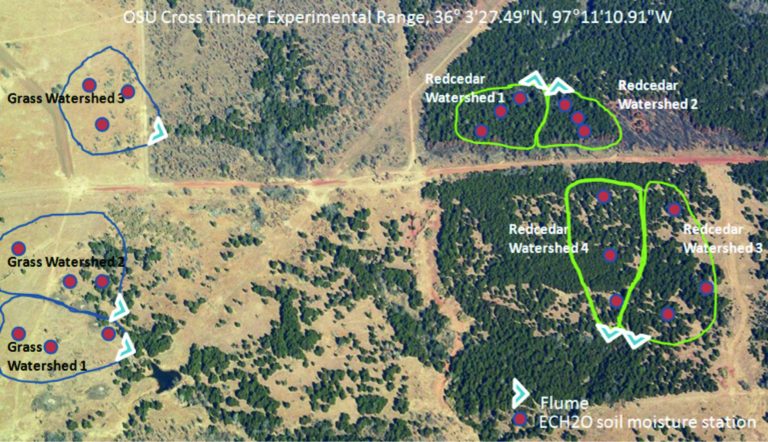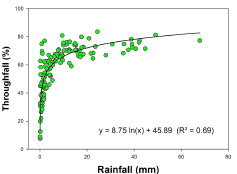Eastern Redcedar Encroachment and Water: Update of 2010 Research
Background
Encroachment of Eastern redcedar (Juniperus virginiana, redcedar) into Oklahoma grasslands is thought to substantially alter local and regional water budgets. This perception assumes that redcedar, compared to herbaceous plants, uses more water in the canopy and extracts deep soil water thereby increasing water loss from evapotranspiration (ET), particularly during winter when grasses are not transpiring.
To test these assumptions, a field-based experiment was initiated at the Cross Timbers Experimental Range near Stillwater. There were three grassland watersheds and three redcedar woodland watersheds selected to assess the influence of redcedar on the water budget (Figure 1). All watersheds have a similar management history, including moderate grazing. Each watershed has three soil-water content stations that measure precipitation and soil water content at depths of 5 cm, 20 cm, 45 cm and 80 cm. Measurements also include ET, canopy interception of precipitation by grasses and redcedar, transpirational water loss by redcedar and streamflow from each watershed.
 Figure 1. This aerial photo of OSU Cross Timbers Experimental Range shows the grassland watersheds
(on the left) that have little redcedar encroachment. The redcedar woodland (on the
right) has about 70 percent canopy cover of redcedar. The project is a multiple-year
collaborative research effort between Oklahoma State University and the USGS Oklahoma
Water Science Center with funding from the USGS-National Institutes of Water Research.
Figure 1. This aerial photo of OSU Cross Timbers Experimental Range shows the grassland watersheds
(on the left) that have little redcedar encroachment. The redcedar woodland (on the
right) has about 70 percent canopy cover of redcedar. The project is a multiple-year
collaborative research effort between Oklahoma State University and the USGS Oklahoma
Water Science Center with funding from the USGS-National Institutes of Water Research.
Results to Date and Significance
Canopy Interception
An analysis of data collected from May 2008 to June 2010 from the redcedar woodland
with closed tree canopy indicated that water loss to redcedar canopy interception
was about 21 percent of the total precipitation of 2,050 mm during this period of
time.
Canopy interception (IC) was defined as the difference between bulk precipitation
(P) and the sum of throughfall (PT), the portion of bulk rainfall that drips off the
canopy and falls through openings, and stemflow (Ps), the water that runs down the
main stems of the redcedar.
Or:
IC = P – (PT + PS)
Our measurements of average throughfall (Figure 2) and stemflow were 69 percent and 10 percent, respectively, of bulk precipitation. Therefore, in units of percent:
IC = 100 – (69+10) = 21%

Figure 2. The percent of bulk rainfall as throughfall for individual storms under the closed-grown redcedar woodland (May 2008 to June 2010).
These preliminary results of canopy interception of closed-grown redcedar are important for two reasons. First, the percent of bulk rainfall from stemflow (10 percent) is substantially higher than expected and deserves more thorough analysis. Second, the redcedar canopy interception of 21 percent falls in the range of grass canopy interception reported for tallgrass prairie. Therefore, quantifying grass canopy interception also is necessary to more reliably assess the effect of redcedar canopy interception on the water budget. Also, the litter layer under redcedar in our site is relatively thick in comparison to the litter layer under grasses, so consideration of rainfall intercepted by the litter layer also may be necessary.
Access to Deep Soil Water
It is generally assumed that redcedar extracts substantial amounts of water from deeper
in the soil. The limited studies on redcedar on soil water extraction have been restricted
mostly to the topsoil, which leaves the hypothesis mostly untested.
Our results indicate that the soil water content profiles and their temporal dynamics
differed substantially between grassland and redcedar woodland (Figure 3). In the
grassland watershed, the soil water content at shallow depths (5 cm, 20 cm) was highly
variable and relatively low compared with that at a deeper depth (80 cm) at the same
time. This was especially true during the growing season, suggesting limited water
uptake from the deep soil by grasses. In contrast, soil water content at 80 cm in
redcedar was low and could be lower than those at the 5 cm and 20 cm depths under
certain conditions, suggesting substantial water uptake by redcedar at this depth.
These results suggest different types of water extraction by redcedar trees and grasses.
Access to a wide range of vertical soil profile by redcedar roots suggest that a larger
pool of soil water would be potentially available for transpiration, resulting in
a different temporal pattern of water use. A generally drier soil profile is less
likely to produce overland flow and baseflow, the main source of streamflow for this
landscape.
Figure 3. Monthly average of soil water content at four soil depths in a grassland watershed and a redcedar watershed.
Summary and Implications
Insufficient data prevent us from drawing conclusions on streamflow response to redcedar encroachment. Our preliminary results indicate that physiological and hydrological processes associated with the grassland and encroached watersheds differ, and these differences are reflected in a general drier soil profile in redcedar woodland than in grassland.
Physical structure of redcedar and water extraction in fall and winter may increase horizontal and vertical differences of soil water, which will likely influence streamflow in the spring. Exact water use during this period will be more precisely calculated using sapflow sensors.
Streamflows at our sites have been infrequent and greatly vary among watersheds under the same cover type. This confirms our experimental design of instrumenting multiple watersheds to account for variability and potential differences resulting from variation in vegetation cover.
Related Fact Sheets and our Website
Oklahoma State University Department of Natural Resource Ecology and Management www.nrem.okstate.edu.
NREM-2876 Eastern Redcedar Control and Management – Best Management Practices to Restore
Oklahoma’s Ecosystems
E-988 Best Management Practices for Controlling Eastern Redcedar
E-927 Using Prescribed Fire in Oklahoma
NREM-2877 Fire Effects in Native Plant Communities
NREM-2878 Fire Prescriptions for Maintenance and Restoration of Native Plant Communities
NREM-2880 Prescribed Burn Associations
E-998 Patch Burning: Integrating Fire and Grazing to Promote Heterogeneity
Chris Zou
Assistant Professor, Ecohydrology and Ecosystem Science
Department of Natural Resource Ecology and Management
Don Turton
Associate Professor, Forest and Wildland Hydrology
Department of Natural Resource Ecology and Management
David Engle
Regents Professor, Rangeland Ecology and Management
Department of Natural Resource Ecology and Management
Thomas E. Berry Professor of Integrated Water Research and Management and Director,
Water Research and Extension Center
Rod Will
Associate Professor, Forest and Wildland Hydrology
Department of Natural Resource Ecology and Management
Sam Fuhlendorf
Sarkeys Distinguished Professor
Department of Natural Resource Ecology and Management
Kim Winton
Director, USGS Oklahoma Water Science Center

